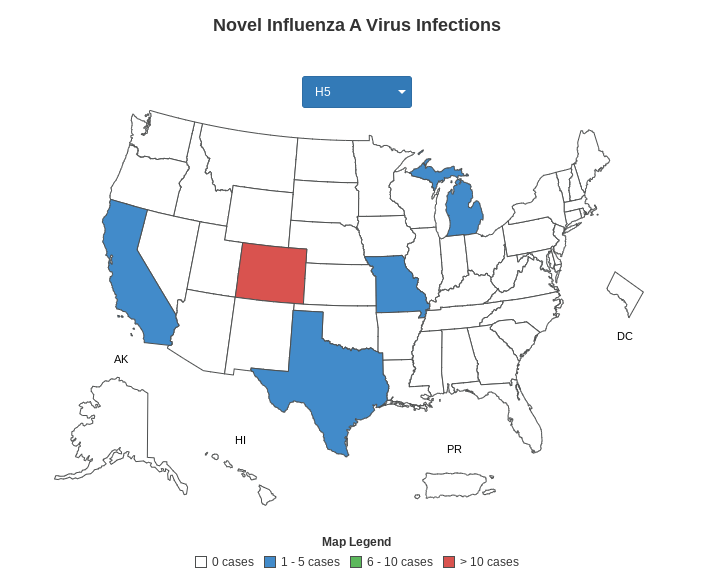As the holidays approach, bird flu is once again sweeping through commercial and backyard poultry flocks, infecting and killing more than 8.9 million turkeys, chickens, and ducks in the U.S…
Bird Flu Spread Continues in Humans, Slowing in Cattle?
Successful Farming’s Chuck Abbott reported that “on the same day the CDC confirmed the third human case of bird flu in California, state officials said Wednesday that they had identified two more possible infections, also farmworkers in the Central Valley. In less than six weeks, California has become the U.S. hot spot for bird flu, with one-third of all the infected dairy herds in the country and all of the human cases since Sept. 6.”
“‘While the risk to the general public remains low, additional human cases of bird flu are expected to be identified and confirmed in California among individuals who have contact with infected dairy cattle,’ said the state Department of Public Health,” Abbott reported. “…Not counting the two latest illnesses, 17 people have been infected by the avian flu virus this year. All but one, reported in Missouri on Sept. 6, were dairy or poultry workers,” Abbott reported.

In addition to the cases in California, Reuters’ Julie Steenhuysen reported that “four additional healthcare workers in Missouri who came in contact with a hospitalized bird flu patient developed mild respiratory symptoms but the virus was not confirmed in any of them, U.S. health officials said on Friday.”
“The report from the U.S. Centers for Disease Control and Prevention brings to six the number of healthcare workers who cared for the Missouri patient and developed respiratory symptoms,” Steenhuysen reported. “Unlike previous U.S. bird flu cases this year, the Missouri patient, who was hospitalized on Aug. 22, had no known contact with infected animals. Scientists are watching closely for signs that the virus has begun to spread more easily in people.”
Infections Slowing In Cattle?
Successful Farming’s Abbott reported in a different article that “although California reported outbreaks of bird flu in 12 dairy herds last week, most states have gone weeks without new cases being discovered, including those with high levels of scrutiny, according to USDA data.”
“Agriculture deputy undersecretary Eric Deeble cited Colorado and Michigan as examples of the tailing off of infections and said during a multi-agency teleconference that ‘this decrease gives us confidence’ of eliminating the virus in dairy cattle by isolating herds,” Abbott reported. “Colorado leads with nation with 64 infected herds but has not reported an outbreak since Aug. 13, said a USDA database. The most recent outbreak in Michigan, which is third in the nation with 29 cases, was Sept. 9. California is second in the nation for outbreaks and accounts for one-fifth of the 256 herds in 14 states.”
Farmers Continue to Push for Vaccine
Reuters’ Leah Douglas and Tom Polansek reported that “U.S. farmers are increasing pressure on the Biden administration to allow vaccinations for chickens, turkeys and cows to protect them from bird flu infections that have devastated flocks for three years.”
“This autumn, flocks in the $67 billion U.S. poultry industry for the first time face a double risk for infections from dairies and migrating birds that can spread the disease,” Douglas and Polansek reported. “Bird flu, which is lethal for poultry and reduces milk output in dairy cows, has eliminated more than 100 million chickens and turkeys since 2022 in the biggest U.S. outbreak ever.”
“Rose Acre Farms, the second-biggest U.S. egg producer, wants the U.S. Department of Agriculture to allow vaccinations, CEO Marcus Rust told Reuters,” Douglas and Polansek reported. “The company lost millions of hens in outbreaks and is relocating an Indiana facility for breeding chickens because it sits across a highway from a wildlife refuge that attracts migratory ducks, he said.”
“The nation’s leading egg, turkey and dairy groups argued in an August letter to Agriculture Secretary Tom Vilsack that the economic toll of the outbreak justifies deploying a vaccine,” Douglas and Polansek reported. “And federal lawmakers say USDA should accelerate its vaccine research and develop new methods to help farmers avoid outbreaks.”
Bloomberg’s Riley Griffin and Rthvika Suvarna reported that “GSK Plc, Sanofi and CSL Ltd. secured $72 million from the US government to ramp up production of bird flu vaccines as a nationwide outbreak among livestock and poultry has led to several human infections that have raised concerns about further spread.”
“The companies will use the funds to fill vials and pre-filled syringes with stockpiled vaccine ingredients, aimed at raising the country’s total supply of ready-to-use doses to 10 million within the first quarter of 2025, Dawn O’Connell, the Department of Health and Human Services’ assistant secretary for preparedness and response, said in an interview with Bloomberg News,” Griffin and Suvarna reported. “…The Administration for Strategic Preparedness and Response has worked with flu vaccine manufacturers since 2005 as part of a program aimed at averting pandemics. The latest award, which includes $37.9 million for CSL, $23.4 million for Sanofi and $10.5 million for GSK, would more than double the nation’s supply of shots targeting bird flu.”
So far, Douglas and Polansek reported, “the U.S. (only) approved emergency use of bird flu vaccine to protect California condors last year. ‘The only use of a vaccine in the U.S. is in this particular case due to the endangered status of that wild bird,’ said Julianna Lenoch, a USDA wildlife disease expert. The U.S. vaccinated 94 condors and saw deaths from bird flu stop, she said on a Thursday webinar.”





